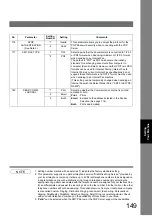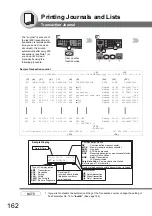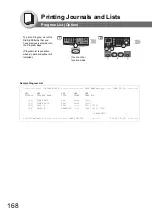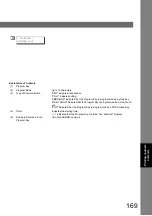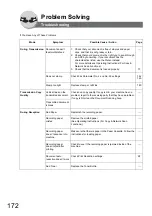
159
Set
ting
Y
our Ma
chine
NOTE
1. If a POP User Account is programmed into the P1 to P4 Program Keys, the data programmed
for this key cannot be deleted, even when the delete command is specified.
2. The Email Address and the Telephone Number cannot be programmed via Email when:
• Auto Dialer Number has been used for communication reservation.
• Received documents are stored in the image data memory of the machine.
• While the machine is communicating or printing.
3. When the Email Address and Telephone Number are programmed via Email, a program result
Email is sent back.
4. Some email applications automatically insert a line feed in the middle of a line when the
number of characters in a line exceed a specific number. Turn "Off" the automatic line feed, or
define the number of characters per line to prevent a line feed, or the data will be ignored.
5. It is available when a Keyboard option is installed.
(2)
@begin to @end
:
Defines the Auto Dialer to be set in section (2) between @begin to @end block.
Edit, Delete or Register the information.
Separate each data field with a semicolon (;). (If the remaining fields are to remain
blank, insert a semicolon (;) for each blank field.)
The data string for each station should be defined within a single line.
The syntax is: <Entry-number>;<Station-name>;<Station-address>;
<Routing-subaddress>;<Routing-id-number>
(a) Entry-number: One-Touch, ABBR. No. or Program Keys to be programmed.
001 to 200: indicates ABBR. No.s 001 to 200 (200 stations maximum)
1001 to 1028: indicates One-Touch numbers from 01 to 28 (See Note 5)
2001 to 2004: indicates Program Keys (P1 to P4 programmed as One-Touch
dialing number) (See Note 5)
(b) Station-name: Name of the station being programmed (15 alpha-numeric
characters maximum).
(c) Station-address: Email Address or telephone number of the station being
programmed.
(d) Routing-subaddress: Sub-Address to be used for routing (20-digit maximum).
(e) Routing-id-number: TSI to be used for routing (20-digit maximum).
(f) The End Receiving Station’s telephone number is entered after the hash sign
(#).
(3)
@program to @end
(See Note 5)
:
Defines the Program Keys stored as a Group Key or POP Access Key to be set in
section (3) between @program to @end block.
Edit, Delete or Register the information.
(a) Program Key: P01 - P04
(b) Station-name as a POP Key: Same as (d) POP User-name.
(c) POP: The syntax used to set the Program Key as a POP Access Key.
(d) POP User-name: Name of the POP User Account (40 alpha-numeric
characters maximum).
(e) POP Password: POP Password (10 alpha-numeric characters maximum).
(f) Set whether the emails on the POP Server are deleted after retrieving the
emails.
(g) Station-name as a Group Key: Name of the station being programmed
(15 alpha-numeric characters maximum).
(h) GROUP: The syntax used to set the Program Key as a Group Key.
(i) Entry-number: One-Touch, ABBR. No. or Program Keys to be programmed.
001 to 200: indicates ABBR. No.s 001 to 200 (200 stations maximum)
1001 to 1028: indicates One-Touch numbers from 01 to 28 (See Note 5)
2001 to 2004: indicates Program Keys (P1 to P4 programmed as
One-Touch dialing number) (See Note 5)
(4)
This header must be deleted before the email is sent to your machine for reprogramming of Auto Dialer.
(5)
The information following the "#" sign is ignored by your machine, therefore, you can leave it as is or delete it if you
wish.
Summary of Contents for Workio DP-1820E
Page 65: ...65 memo Internet Fax Features ...
Page 113: ...113 memo Advanced Internet Fax Features ...
Page 161: ...161 memo Setting Your Machine ...
Page 201: ......





